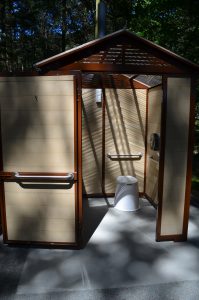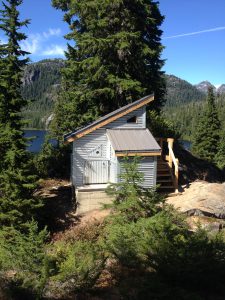Know Before You Go: The Toilet Edition
Categories:
Exploring a park can be a unique experience for every visitor, but there’s one facility common to any outdoor trip: the outhouse. You may think you’re familiar with these amenities, but there’s actually a lot that goes on under the lid that you may not know about. While you don’t need to become a commode connoisseur, understanding a bit about how your business becomes our business ensures that these toilets remain functional for all users.
This is only the beginning of toilets in our parks. New designs are constantly being considered and tested. But the most important thing to know is that outdoor loos are for pee and poo. They’re not for uneaten snacks, candy wrappers, diapers, your broken headlamp, old shirts, or that one tent pole that looks important, but you can’t quite figure out where it’s supposed to go.
So, you’re going for a trip to a frontcountry campground. Maybe you’re at a park, enjoying a peaceful sunset and, all of a sudden, nature calls. What toilets are you likely to find in a frontcountry campsite like this one?
Flush Toilets
Like many parks with day-use areas, you might find yourself using a flush toilet. Other than being nestled in the middle of a beautiful park, these are pretty much the same toilets you’re used to using at home. Keep your stall clean and tidy for the next user, and don’t flush anything down that you wouldn’t put in your toilet at home. A backed-up toilet is a friend to no bum.
Pit Toilets

Pit toilets are very common in the frontcountry (and in the backcountry. The one constant that you can be sure of is that all our toilets are made for human waste and human waste only. But throwing garbage on the floor of the bathroom is not a good alternative, either. Garbage is bad for the environment, attracts animals, and is generally just not a pretty sight. Either throw it in a garbage can or pack it out.
In frontcountry locations, such as Montague Harbour, you might stumble upon some pump-out pit toilets. These are near roads, so they are accessible by trucks which can siphon everything out from the sealed concrete pump-out pits. Garbage in the pits can clog these siphons, and trust us, that’s not a pretty picture. Remember, when you throw something in the pit that doesn’t belong there, someone else has to go through and pick it out. Not fun. These blockages can also cause breakages, which means big bucks for the taxpayer.
You also might come across pit toilets while hiking in the backcountry. Managing waste in the backcountry is especially expensive because waste must be removed, typically using boats or helicopters.
Many backcountry pit toilets are being converted into urine diversion toilets and include some pretty funky technology. Come along for a trek to find out more!
You’ve practiced your outdoor skills and packed the essentials, and you’re off on a trip in the backcountry. Once again, you’re in need of a bathroom. What will you find? In some locations you’ll find similar pit toilets to the ones mentioned above. These remote locations are not accessible by vehicle, so waste removal is traditionally done by flying full barrels out for proper disposal. Depending on the location and usage of the toilet, this could be required up to two to three times per season. But new and exciting things are happening in the world of remote toilets, which is where urine diversion comes in.

Urine Diversion Toilets
Urine diversion toilets do exactly what you’d expect: they separate number one from number two. Urine is immediately diverted out of the system and percolates into a disposal field . Any solid waste and toilet paper left behind lands on a small conveyor system. All you have to do is pump a foot pedal 4 or 5 times to transport the waste along the conveyor belt to be collected in a separate chamber. What you shouldn’t do is throw any garbage in the toilet, clogging the conveyor and leaving the toilet unusable. After all, it’d be a shame to have to hold it.
Without urine, solid waste decomposes much more efficiently, so this system can operate for years depending on each toilet design, before any waste needs to be collected, which is a lot less frequent than traditional pit toilet models and much more environmentally, and financially friendly. An added bonus is that this waste has a lot less odour than a conventional fly-out toilet. Say hello to funky technology and goodbye to funky smells.
Packing Out
If there’s no outhouse around, or you’re in a real emergency, the best practice is to bury all your waste in a shallow hole located at least 60m (200 feet) from any water sources, campsites, and trails. Be sure to pack out everything else, including toilet paper.
Want to learn more about urine diversion toilets? Check out this Popular Science article by Ula Chrobak. Check out the impact BC Parks and other parks systems are making in the world of urine diversion, vermicomposting, and the “backcountry toilet revolution”.




